Sabre Blog
I haven't blogged about Zeus for a while. In Miami, I tested boats with Zeus drives from CAT and from Yanmar which showed me that by choosing Zeus over the other azipod drive system, we left open our customer's options to select engines from other engine builders. We don't plan anything for the short term because both CAT and Yanmar are early into the game and don't yet have the level of development that Cummins does but they are on their way. Both companies will be using the same Mototron Joy Stick, SmartCraft display and Glendinning controls. BTW we have also chosen IPS for our pod application in the Sabre 38 Express.

Zeus Pods need to be placed within a specific distance from the transom for a lot of performance reasons and because they include the automatic trim tabs as part of their standard offering. Many boatbuilders have installed Zeus in existing designs as we did with the Sabre 42 Express. Fortunately the 42 Express cockpit is well laid out for Zeus with three large hatches offering great access to the lazarette. On the new Sabre 40 we designed the cockpit so that the aft cockpit seat hinges forward and allows wide access over the pods. In addition to this hatch there are two other hatches for accessing the storage spaces below the cockpit deck.
More about the clever cockpit table design and cockpit seating next time. (Public) Launch day is still set for May 1st.
Posted in Sabre Yachts Blog | Comments Off on Zeus Pods
Here in Maine we have seasons just like everyone else does but we have an extra one. It's called "mud season". That's the time between the really good sledding and when the black flies start biting. We don't really think about it much but we do notice that once the snow has started to melt and the parking lot is six inches deep in brown sludge, that people from "away" come to visit. It starts slow and before you know it the visitor traffic is at a steady ebb and flow.<p>
Last week there were plenty of reasons to come to Maine. First of all it didn't snow for an entire week (we're on a roll) and second,we had the Maine Boatbuilders Show. If you have never attended you have to put it on your calendar for next year. It's what people call the "boat show with soul".<p>
Two couples who are both building Sabre 40 Sedans came up to view our progress last week and take in the boat show at the same time. It was fun watching them tip toe through the mud and even more fun watching their grins as they viewed the Sabre 40 for the first time. They both read my blog so I am hoping they might jump in a tell everyone how much fun they are having. If they want to remain anonymous don't worry you can recognize them by the mud on their shoes.
Posted in Sabre Yachts Blog | Comments Off on Mud Season and Visitors
I am an observer of people. That's what marketing people do, They observe and then react with solutions to concernsor desires that have been expressed by potential clients. Electrical systems controls are a pet peeve of mine. Whoever wrote the electrical codes for boats wasn't married I am fairly certain and I am absolutely sure that they were not of an age that reading glasses needed to be worn to read small labels.
After watching boaters around electrical panels for most of my carreer (I have done some other stuff too) I think that making the basic electrical controls simpler to understand and operate might add as much as ten years to the average boater's marriage. It seems that there is never a good time to ask your boat mate to turn on a breaker. Since there is a built in fear hiding inside each one of these things most crew members are hesitant to switch the wrong switch for fear of something coming on or being turned off that should not have been. I've even seen professionals leave bilge pump switches in the "off" (as opposed to auto or on) position and have a boat almost sink as a result.
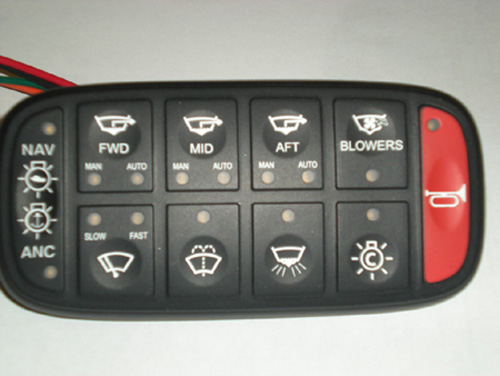
So here's the helm panel for the new Sabre 40. It has navigational lights, three bilge pumps, blowers, wipers (two speed), washers and horn incorporated. BTW we can just "y" in a second panel and run that up to the bridge and the only things that need to go back and forth are four wires. If the function of each of these switches isn't obvious then we may have a bigger problem but I think you'll get the drift. I like the use of symbols to make the use more obvious and the small light that will illuminate when that function is active.
The panel is from Digital Switching (the DNA Group) and they are really making things better for boaters with stuff like this. They may be adding to marital bliss as well.
Posted in Sabre Yachts Blog | Comments Off on Making Electrical Systems Simple
When you live here in Maine and the winter starts to drag on, the very mention of sunshine picks you up, This week, prior to decking the new Sabre 40, we installed the optional Webasto sun roof which we have used with great success and to rave reviews on the Sabre 52 Express. It truly is an amazing feature on this style of boat and I can't wait to run the 40 on a sunny day. It will be awesome.
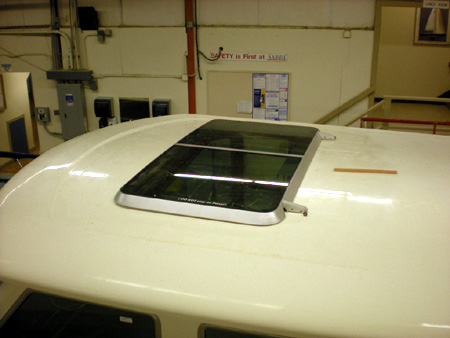
The roof opens in two ways just like a car sun roof (in fact Webasto has a world of automotive experience to call on). It can open to a vent position or can be fully retracted to open up the roof of the vessel. The shape of the forward edge of the hard top controls the air turbulence entering the cabin. Many buyers have requested a forward opening windshield but that is not possible due to the need to have a centerline piston to open and close the window. In the case of the Sabre 40 there is nothing but open space above the galley ergo nowehere to put the piston. The better alternative is this overhead sunroof with shade. Combine that with all of the opening doors and windows in the house and there's plenty of air flow on this design.
Posted in Sabre Yachts Blog | Comments Off on Let the Sun Shine in
Nida Core is a honeycomb coring the material that we chose on the Sabre 52 to give that boat sound levels (I should call them quiet levels) that have rarely before been seen in planing powerboats. That design achieved 75 Db at 25 knots and in that case we are running two CAT C15's at 865 hp each. That's remarkable.
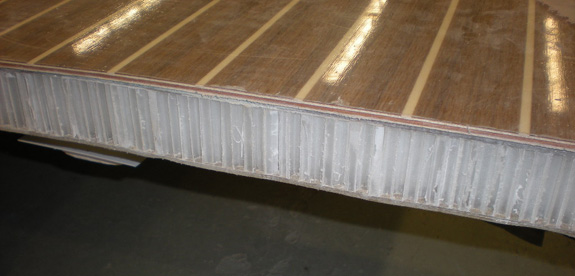
With the Sabre 40 we are hoping for similar results and we are once again counting on Nida Core to produce them. But the 40 has an additional advantage and that is the Zeus drive train. When the boat is idling at rest exhaust gasses will exit through a small diameter by pass. When underway exhaust gasses (and their related noise) exit underwater with the prop wash and this, as we already know from our 42 Express experience, really quietens down the overall build.
Next time you pick up a magazine with a boat review check out noise levels. And remember that the difference between 72 and 80 is about the difference between conversation and a rock concert. It's important for the enjoyment of boating.
Posted in Sabre Yachts Blog | Comments Off on Silence is Golden
For the casual observer,not a lot of attention is paid to the side door that we have worked so hard to incorporate into the Sabre 40. Some readers may not have even noticed the door in the renderings but it is a really big deal for the people who are serious about this design. If you know our powerboats from the 90's you will know that we never truly conquered the "seal around the side door" issue. Sliding doors are simply hard to build and hard to make air tight. So when we set about designing the 40, the side door presented a challenge for the Design Team. Call it Yankee Ingenuity or just plain smart but the final design is brilliant (in our humble opinion)
Let's start at the beginning, Designs have to have a certain beam to length ratio to perform in the desired envelope. Here's where the decisions begin. How wide do the side decks need to be? For Sabre they have to be safe and secure. No white plastic boat mini decks for us. I hope you can see where I am headed. Now, after deducting the side deck dimension from the beam we have the width of the salon remaining. The balance is key. Back to the side door.
The best way to make the side door work (and have it be air tight) is to have it hinge aft and lay against the side of the house. But if the side deck is narrower than a reasonable door is wide, clever design has to overcome. You'll see on these images that our side door has the bottom foot or so cut back so that when the door swings it passes inside the lower guard rail.Good ergonomics tell us that our feet don't care if something is narrow but our hips and shoulders need to feel like they can fit easily through an opening. So the wedge shape at the bottom is our way of giving you a great side door and keeping both side deck width and salon width where they should be.
Ta Da !
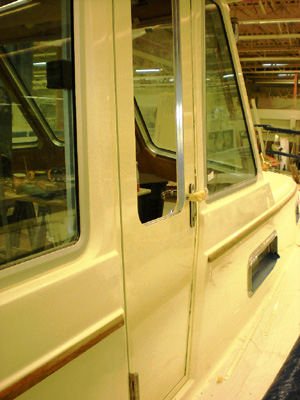
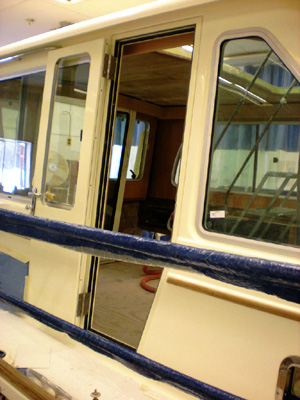
Posted in Sabre Yachts Blog | Comments Off on Side Door Decision
Modern boats have thousands of feet of electrical wiring in them. Unlike your house that only has AC wiring, a boat also has DC or 12 volt wiring. There are plenty of sub topics when it comes to wiring so today I just want to start by scratching the surface.
If you are a salt water boater you have probably witnessed what salt water and air do to copper wire over time. We've all seen that green powder that you find on exposed wires. Well there is a way that boatbuilders can avoid these electrical faults and that is with the use of tinned wire. It costs more so plenty of builders don't use it. Sabre does. Our wire suppliers take the common copper wire and they draw that wire through a bath of tin prior to enveloping it in the plastic outer casing. The result is a wire that is highly resistant to corrosive failures. It's the right wire to use in a boat.
In this image our electrician Bob, is pulling wires for the Sabre 40 sedan's electrical system. He has hundreds of wires to pull and in order to identify each one, he will label the ends of each wire with a number that corresponds to the label at the other end. The owner will have chart attached to their electrical panel (and also in the owner's manual) that clearly identifies each wire. In the event of an electrical problem, fault tracing is far simpler and less time consuming.
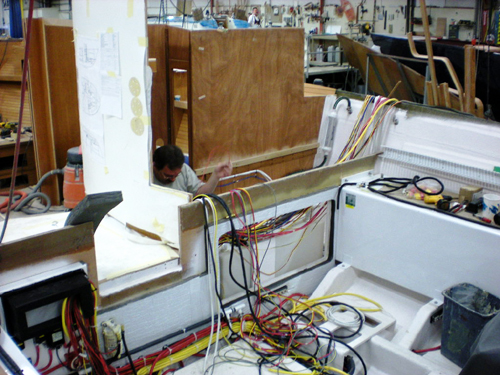
More on wires and electrical systems as the boat gets closer to completion.
Posted in Sabre Yachts Blog | Comments Off on Wired
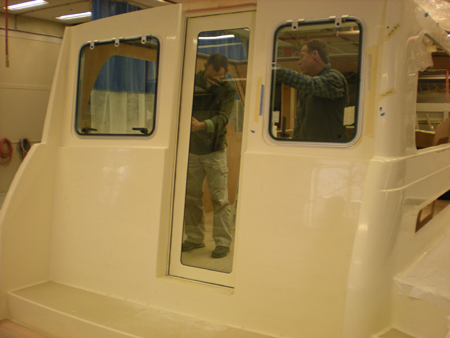
Connecting interior and exterior spaces is the latestdesign challenge in the motor yacht industry and our own Sabre Design team has come up with some innovative ideas. In this image Glen Campbell and Rick Paul from the engineering group are test fitting the door and windows into the deck of hull one.
The door is floor to ceiling glass with a minimal frame. The door is on tracks and slides to port rather than hinge open to the cockpit and consume valuable living space in doing so. The two large windows seen here are hinged on the top edge and gas shocks raise thewindow panels up to a horizontal position. Air flow will be plentiful and with the addition of the optional sun roof the interior of the Sabre 40 will feel like an outdoor space.
Because the deck mold is used for both sedan and bridge models the port side aft facing seat and the optional grille/icemaker cabinet are secondaries that are added to the deck. The white "walls" seen here will be cut down in height by about half once the seat and grille cabinet are installed,
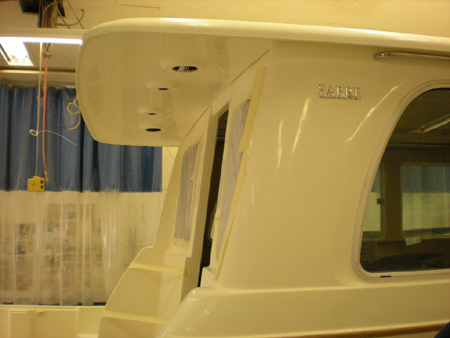
Here's a first glimpse of the hard top and overhang. As you can see this is long enough to cover both the seat and the windows in their up position.
Posted in Sabre Yachts Blog | Comments Off on Light and air
From the first days of the discussion about the mid-galley we have thought that it would be a nice idea to break up the different cabin soles (a.k.a. floors) so that a crew member moving from one level to the other would be more aware that they are about to step up or down. (Like those black and yellow tapes you see when there's construction near you but those tapes, we decided, would not look great with our fabulous interior joinery.) The main salon and lower passageway flooring is traditional teak and holly. The steps above and below the galley sole are cherry with maple inlays: a good non-skid surface.
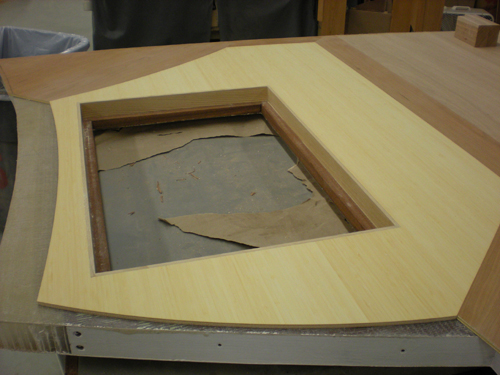
Here's an image of the galley sole that we have decided on. The border is traditional cherry to match the steps. The interior piece is bamboo; a flooring material that has become very popular in homes. It is highly resistant to impact damage and very stable. You may be able to see in the lower left hand corner that this sole is supported on a Nida-Core base, a material which helps to reduce noise and creates a stiff and stable medium on which to put the sole. The hatch that you see here is a blog topic for another day (hint there's a bunch of things in there that the boat owner will need to get to for service)
Posted in Sabre Yachts Blog | Comments Off on A Different Sole
Installation of the drive train system progressed on the Sabre 40 this week with the installation of the two Cummins QSB 5.9 380 hp standard engines. We've had plenty of experience with the QSB engines having installed many of them in our 34 and 38 footers in addition to the many we have installed in our Back Cove range of boats. The mechanical associates are loving the space they have to work in just as you will when doing daily checks or servicing these engines.
The QSB series engines are strong, dependable, quiet and clean. I have one in my own boat and after 100 hours I would have to say that servicing is a misnomer since all I have done is check fluids and do visual checks and nothing else has been required. Sweet. Sorry back to the topic at hand………

In this image one can see the two saddle fuel tanks, each with a capacity of 200 gallons plusexpansion room. The port side tank will feed both the port engine and the genset and there is a cross over between port and starboard tanks to keep things level. Fuel monitoring is standard with the Smartcraft display provided at the helm. And if you are really observantt you'll note the oil changing system which is mounted on the aft side of the bulkhead and will be operated from the lazarette.
Posted in Sabre Yachts Blog | Comments Off on Mechanical space galore
